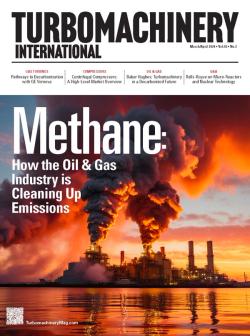
OR WAIT null SECS
© 2024 MJH Life Sciences™ and Turbomachinery Magazine. All rights reserved.
MYTH BUSTERS
SUPERCRITICAL CO2 POWER PLANTS: ARE THEY REAL? 52 Turbomachinery
The concept to use supercritical carbon dioxide (S-CO2) as a working fluid in a power cycle has been around since the 1940s and was intensively investigated, primarily for nuclear applications in the 1960s by several nuclear power plant providers. However, the demise of new nuclear construction in the U.S. in the 1970s led to abandonment of most of the development work in this area.
Recently, there has been — at least in the R&D arena — strong renewed interest in S-CO2 power cycle and a number of the energy industry OEMs, universities, and research institutes are actively pursuing technology development in this area. Potential applications of S-CO2 power cycles beyond nuclear power include waste heat recovery, solar concentrating power, geothermal, oxy-fueled fossil plants, and even ship-board propulsion.
Thus, with S-CO2 power cycle being the fashion du jour (Sept/Oct12, p. 22) and since Brun and Kurz have wildly divergent opinions about this technology, we decided to write a “he says - he says” article, something we have not done in a long time.
What Brun has to say:
CO2 is a safe, clean, and inexpensive working fluid with minimal environmental risk. There are many significant advantages of SCO 2 as a process fluid for a closed power cycle. Most important is that one can achieve high efficiencies at relatively low firing temperatures. An open air simple Brayton cycle would have to operate at firing temperatures well above 3,200°F, which exceed current active cooling and material technology limits. To reach the 50% simple cycle barrier, a closed loop S-CO2 cycle achieves that efficiency at just above 1,200°F.
For this the closed S-CO2 cycle must operate above 3,500 psi, but the technology is well understood for high-pressure loops, turbomachinery and heat exchangers. CO2 compression above 10,000 psi has been demonstrated in the oil & gas industry albeit at lower temperatures.
Because S-CO2 is a dense fluid with a high energy density, the utilization of small and compact turbomachinery is possible. For example a 20MW single-stage expander for S-CO2 can be designed to have a diameter of less than 10 inches, which is about half the diameter a similar steam turbine expander would require. The lower thermal mass makes responding to startup and load changes faster for frequent start-up and shut-down operations. Also, the high fluid densities of S-CO2 give high mass flow rates at low volume flow rate resulting in compact, low-weight, and low-cost power block equipment.
Unlike steam, whose state-of-the-art is limited to operating temperatures below 1,200°F because of material corrosion and hydrogen embrittlement, CO2 has no such limitation and, similar to air, allows for ready implementation of advanced blade cooling methods. S-CO2 is miscible in metals and can cause surface abrasion but this process is not as damaging as steam corrosion.
With current cooling and material technology, S-CO2 cycle operating temperatures above 1,400°F should be achievable. As with all closed loop power cycles, heat exchangers will be required in S-CO2 cycles, which can be bulky and expensive. However, with the advent of micro-channel heat exchangers, manufactured using diffusion bonding of multiple plates, which are either traditionally or chemically machined, there is significant potential for cost and size reduction.
Finally, oxy-fueled fossil power plants, using S-CO2 in the cycle provide the potential for sequestration-ready CO2 at pipeline pressures, eliminating the need for CO2 separation and re-compression. If CO2 greenhouse gas emissions legislation is ever enacted, S-CO2 oxy-fueled cycles will be a critical enabling technology that will allow the U.S. to continue to use coal as a power plant feedstock.
Kurz takes the contrarian view:
Undoubtedly, S-CO2 is the new “hot ticket” in power generation. It certainly promises a number of advantages, not the least being high cycle efficiencies and a smaller footprint. However, having gone through the “hydrogen economy,” the promises from fuel cell hybrids, and still remembering the ultimately abandoned attempt to use a closed loop helium gas turbine in Germany in the 70s, I have to voice some concerns related to this technology.
One of the big advantages of S-CO2 cycles, the high power density, also comes at the price of having to operate at pressures that are higher than used for any gas turbine. This means that S-CO2 turbomachinery cannot be based on existing gas turbines, since the rotordynamic challenges as well as issues like blade stresses, as well as aerodynamic behavior will essentially force a clean sheet of paper design.
Admittedly, the helium gas turbine in Germany was designed 40 years ago, but it surprised its designers with a thermal efficiency of about 23% instead of the predicted 34%. One of the issues of higher power density will be the management of leakage flows, and probably windage losses. Thus, I would argue that it will be many years until a truly useful and commercially viable design will be available, and chances are that insurmountable problems will cause the abandonment of the project.
Like many other advanced cycles, the S-CO2 cycles that are currently proposed rely heavily on heat exchangers. Large, reliable, effective, and efficient heat exchangers for gases at considerable pressure and temperature may have to be developed to further the technology. These heat exchangers will have to prove their reliability in thousands of hours of operation and numerous thermal cycles. Starting up a machine involving a large thermal mass might prove challenging and time consuming.
While CO2 shows favorable thermodynamic properties, and in particular allows for good thermal efficiency at lower temperatures (for the same theoretical Brayton Cycle efficiency, a Helium Cycle would have to run about 250°C hotter than a CO2 cycle), CO2 is not entirely chemically inert and can actually cause corrosion, especially at high pressures.
Another issue might be that CO2 near its critical point is sensitive to contamination. Therefore, contamination can quickly lead to performance deterioration due to component mismatch. Further, the performance of current turbomachinery has been optimized using CFD codes. Air and high temperature exhaust gas show fairly benign behavior. The very sensitive real gas behavior of supercritical CO2 will slow these codes down, and may make results less reliable.
A final point for complex cycles with larger thermal mass is the control during off-design conditions, upset conditions, as well as the start-up and shutdown. Experience with small-scale demonstrations does not easily scale to commercial size plants regarding their dynamic behavior.
We welcome your opinion and input on this interesting and important topic and will make every attempt to respond to your letters.
Authors
Klaus Brun is the Machinery Program Director at Southwest Research Institute in San Antonio, Texas. He is also the past Chair of the Board of Directors of the ASME International Gas Turbine Institute and the IGTI Oil & Gas applications committee.
Rainer Kurz is the manager of systems analysis for Solar Turbines Incorporated in San Diego, CA. He is an ASME Fellow since 2003 and past chair of the IGTI Oil & Gas applications committee.


